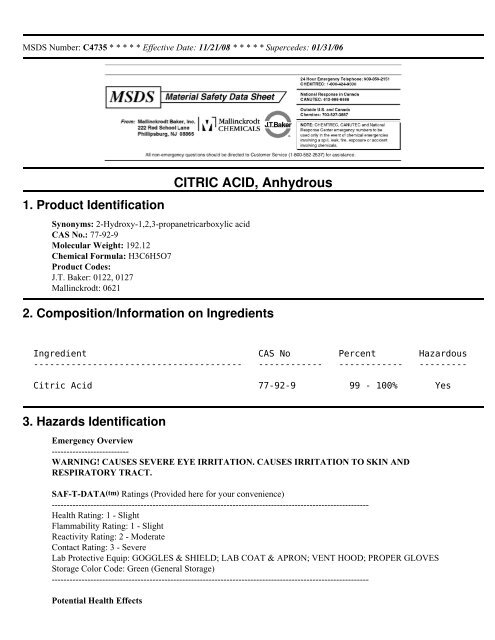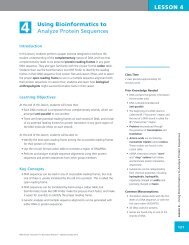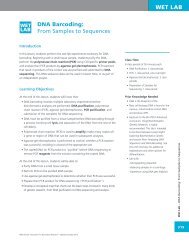MSDS Citric Acid
MSDS Citric Acid
MSDS Citric Acid
Create successful ePaper yourself
Turn your PDF publications into a flip-book with our unique Google optimized e-Paper software.
<strong>MSDS</strong> Number: C4735 * * * * * Effective Date: 11/21/08 * * * * * Supercedes: 01/31/06<br />
1. Product Identification<br />
Synonyms: 2-Hydroxy-1,2,3-propanetricarboxylic acid<br />
CAS No.: 77-92-9<br />
Molecular Weight: 192.12<br />
Chemical Formula: H3C6H5O7<br />
Product Codes:<br />
J.T. Baker: 0122, 0127<br />
Mallinckrodt: 0621<br />
CITRIC ACID, Anhydrous<br />
2. Composition/Information on Ingredients<br />
Ingredient CAS No Percent Hazardous<br />
--------------------------------------- ------------ ------------ ---------<br />
<strong>Citric</strong> <strong>Acid</strong> 77-92-9 99 - 100% Yes<br />
3. Hazards Identification<br />
Emergency Overview<br />
--------------------------<br />
WARNING! CAUSES SEVERE EYE IRRITATION. CAUSES IRRITATION TO SKIN AND<br />
RESPIRATORY TRACT.<br />
SAF-T-DATA(tm) Ratings (Provided here for your convenience)<br />
-----------------------------------------------------------------------------------------------------------<br />
Health Rating: 1 - Slight<br />
Flammability Rating: 1 - Slight<br />
Reactivity Rating: 2 - Moderate<br />
Contact Rating: 3 - Severe<br />
Lab Protective Equip: GOGGLES & SHIELD; LAB COAT & APRON; VENT HOOD; PROPER GLOVES<br />
Storage Color Code: Green (General Storage)<br />
-----------------------------------------------------------------------------------------------------------<br />
Potential Health Effects
----------------------------------<br />
Inhalation:<br />
Causes irritation to the respiratory tract. Symptoms may include coughing, shortness of breath.<br />
Ingestion:<br />
Causes irritation to the gastrointestinal tract. Symptoms may include nausea, vomiting and diarrhea. Extremely<br />
large oral dosages may produce gastrointestinal disturbances. Calcium deficiency in blood may result in severe<br />
cases of ingestion.<br />
Skin Contact:<br />
Causes irritation to skin. Symptoms include redness, itching, and pain.<br />
Eye Contact:<br />
Highly irritating; may also be abrasive.<br />
Chronic Exposure:<br />
Chronic or heavy acute ingestion may cause tooth enamel erosion.<br />
Aggravation of Pre-existing Conditions:<br />
No adverse health effects expected.<br />
4. First Aid Measures<br />
Inhalation:<br />
Remove to fresh air. If not breathing, give artificial respiration. If breathing is difficult, give oxygen. Get<br />
medical attention.<br />
Ingestion:<br />
Induce vomiting immediately as directed by medical personnel. Never give anything by mouth to an<br />
unconscious person. Get medical attention.<br />
Skin Contact:<br />
Immediately flush skin with plenty of water for at least 15 minutes. Remove contaminated clothing and shoes.<br />
Get medical attention. Wash clothing before reuse. Thoroughly clean shoes before reuse.<br />
Eye Contact:<br />
Immediately flush eyes with plenty of water for at least 15 minutes, lifting lower and upper eyelids occasionally.<br />
Get medical attention immediately.<br />
5. Fire Fighting Measures<br />
Fire:<br />
Autoignition temperature: 1011C (1852F)<br />
As with most organic solids, fire is possible at elevated temperatures or by contact with an ignition source.<br />
Explosion:<br />
Fine dust dispersed in air in sufficient concentrations, and in the presence of an ignition source is a potential dust<br />
explosion hazard.<br />
Fire Extinguishing Media:<br />
Water spray, dry chemical, alcohol foam, or carbon dioxide.<br />
Special Information:<br />
In the event of a fire, wear full protective clothing and NIOSH-approved self-contained breathing apparatus with<br />
full facepiece operated in the pressure demand or other positive pressure mode.<br />
6. Accidental Release Measures<br />
Ventilate area of leak or spill. Wear appropriate personal protective equipment as specified in Section 8. Spills:<br />
Sweep up and containerize for reclamation or disposal. Vacuuming or wet sweeping may be used to avoid dust<br />
dispersal.
7. Handling and Storage<br />
Keep in a tightly closed container, stored in a cool, dry, ventilated area. Protect against physical damage.<br />
Containers of this material may be hazardous when empty since they retain product residues (dust, solids);<br />
observe all warnings and precautions listed for the product.<br />
8. Exposure Controls/Personal Protection<br />
Airborne Exposure Limits:<br />
None established.<br />
Ventilation System:<br />
A system of local and/or general exhaust is recommended to keep employee exposures as low as possible. Local<br />
exhaust ventilation is generally preferred because it can control the emissions of the contaminant at its source,<br />
preventing dispersion of it into the general work area. Please refer to the ACGIH document, Industrial<br />
Ventilation, A Manual of Recommended Practices, most recent edition, for details.<br />
Personal Respirators (NIOSH Approved):<br />
For conditions of use where exposure to dust or mist is apparent and engineering controls are not feasible, a<br />
particulate respirator (NIOSH type N95 or better filters) may be worn. If oil particles (e.g. lubricants, cutting<br />
fluids, glycerine, etc.) are present, use a NIOSH type R or P filter. For emergencies or instances where the<br />
exposure levels are not known, use a full-face positive-pressure, air-supplied respirator. WARNING:<br />
Air-purifying respirators do not protect workers in oxygen-deficient atmospheres.<br />
Skin Protection:<br />
Wear impervious protective clothing, including boots, gloves, lab coat, apron or coveralls, as appropriate, to<br />
prevent skin contact.<br />
Eye Protection:<br />
Use chemical safety goggles and/or full face shield where dusting or splashing of solutions is possible. Maintain<br />
eye wash fountain and quick-drench facilities in work area.<br />
9. Physical and Chemical Properties<br />
Appearance:<br />
White granules.<br />
Odor:<br />
Odorless.<br />
Solubility:<br />
ca. 60 g/100 ml @ 20C (Anhydrous)<br />
Density:<br />
1.665 @ 20C/4C<br />
pH:<br />
2.2 (0.1 N sol)<br />
% Volatiles by volume @ 21C (70F):<br />
0<br />
Boiling Point:<br />
No information found.<br />
Melting Point:<br />
153C (307F)<br />
Vapor Density (Air=1):<br />
No information found.<br />
Vapor Pressure (mm Hg):<br />
No information found.<br />
Evaporation Rate (BuAc=1):<br />
No information found.
10. Stability and Reactivity<br />
Stability:<br />
Stable under ordinary conditions of use and storage.<br />
Hazardous Decomposition Products:<br />
Carbon dioxide and carbon monoxide may form when heated to decomposition.<br />
Hazardous Polymerization:<br />
Will not occur.<br />
Incompatibilities:<br />
Metal nitrates (potentially explosive reaction), alkali carbonates and bicarbonates, potassium tartrate. Will<br />
corrode copper, zinc, aluminum and their alloys.<br />
Conditions to Avoid:<br />
Heat, flames, ignition sources and incompatibles.<br />
11. Toxicological Information<br />
Oral rat LD50: 3 gm/kg; irritation skin rabbit: 500 mg/24H mild; eye rabbit: 750 ug/24H severe.<br />
--------\Cancer Lists\------------------------------------------------------<br />
---NTP Carcinogen---<br />
Ingredient Known Anticipated IARC Category<br />
------------------------------------ ----- ----------- -------------<br />
<strong>Citric</strong> <strong>Acid</strong> (77-92-9) No No None<br />
12. Ecological Information<br />
Environmental Fate:<br />
No information found.<br />
Environmental Toxicity:<br />
No information found.<br />
13. Disposal Considerations<br />
Whatever cannot be saved for recovery or recycling should be managed in an appropriate and approved waste<br />
disposal facility. Processing, use or contamination of this product may change the waste management options.<br />
State and local disposal regulations may differ from federal disposal regulations. Dispose of container and<br />
unused contents in accordance with federal, state and local requirements.<br />
14. Transport Information<br />
Not regulated.<br />
15. Regulatory Information<br />
--------\Chemical Inventory Status - Part 1\---------------------------------<br />
Ingredient TSCA EC Japan Australia<br />
----------------------------------------------- ---- --- ----- ---------<br />
<strong>Citric</strong> <strong>Acid</strong> (77-92-9) Yes Yes Yes Yes<br />
--------\Chemical Inventory Status - Part 2\---------------------------------<br />
--Canada--
Ingredient Korea DSL NDSL Phil.<br />
----------------------------------------------- ----- --- ---- -----<br />
<strong>Citric</strong> <strong>Acid</strong> (77-92-9) Yes Yes No Yes<br />
--------\Federal, State & International Regulations - Part 1\----------------<br />
-SARA 302- ------SARA 313------<br />
Ingredient RQ TPQ List Chemical Catg.<br />
----------------------------------------- --- ----- ---- --------------<br />
<strong>Citric</strong> <strong>Acid</strong> (77-92-9) No No No No<br />
--------\Federal, State & International Regulations - Part 2\----------------<br />
-RCRA- -TSCA-<br />
Ingredient CERCLA 261.33 8(d)<br />
----------------------------------------- ------ ------ ------<br />
<strong>Citric</strong> <strong>Acid</strong> (77-92-9) No No No<br />
Chemical Weapons Convention: No TSCA 12(b): No CDTA: No<br />
SARA 311/312: Acute: Yes Chronic: No Fire: No Pressure: No<br />
Reactivity: No<br />
(Pure / Solid)<br />
Australian Hazchem Code: None allocated.<br />
Poison Schedule: None allocated.<br />
WHMIS:<br />
This <strong>MSDS</strong> has been prepared according to the hazard criteria of the Controlled Products Regulations (CPR) and<br />
the <strong>MSDS</strong> contains all of the information required by the CPR.<br />
16. Other Information<br />
NFPA Ratings: Health: 2 Flammability: 1 Reactivity: 0<br />
Label Hazard Warning:<br />
WARNING! CAUSES SEVERE EYE IRRITATION. CAUSES IRRITATION TO SKIN AND<br />
RESPIRATORY TRACT.<br />
Label Precautions:<br />
Avoid contact with eyes, skin and clothing.<br />
Avoid breathing dust.<br />
Keep container closed.<br />
Use only with adequate ventilation.<br />
Wash thoroughly after handling.<br />
Label First Aid:<br />
In case of contact, immediately flush eyes or skin with plenty of water for at least 15 minutes. Remove<br />
contaminated clothing and shoes. Wash clothing before reuse. If inhaled, remove to fresh air. If not breathing,<br />
give artificial respiration. If breathing is difficult, give oxygen. In all cases, get medical attention.<br />
Product Use:<br />
Laboratory Reagent.<br />
Revision Information:<br />
No Changes.<br />
Disclaimer:<br />
************************************************************************************************<br />
Mallinckrodt Baker, Inc. provides the information contained herein in good faith but makes no<br />
representation as to its comprehensiveness or accuracy. This document is intended only as a guide to the<br />
appropriate precautionary handling of the material by a properly trained person using this product.
Individuals receiving the information must exercise their independent judgment in determining its<br />
appropriateness for a particular purpose. MALLINCKRODT BAKER, INC. MAKES NO<br />
REPRESENTATIONS OR WARRANTIES, EITHER EXPRESS OR IMPLIED, INCLUDING<br />
WITHOUT LIMITATION ANY WARRANTIES OF MERCHANTABILITY, FITNESS FOR A<br />
PARTICULAR PURPOSE WITH RESPECT TO THE INFORMATION SET FORTH HEREIN OR<br />
THE PRODUCT TO WHICH THE INFORMATION REFERS. ACCORDINGLY, MALLINCKRODT<br />
BAKER, INC. WILL NOT BE RESPONSIBLE FOR DAMAGES RESULTING FROM USE OF OR<br />
RELIANCE UPON THIS INFORMATION.<br />
************************************************************************************************<br />
Prepared by: Environmental Health & Safety<br />
Phone Number: (314) 654-1600 (U.S.A.)
















